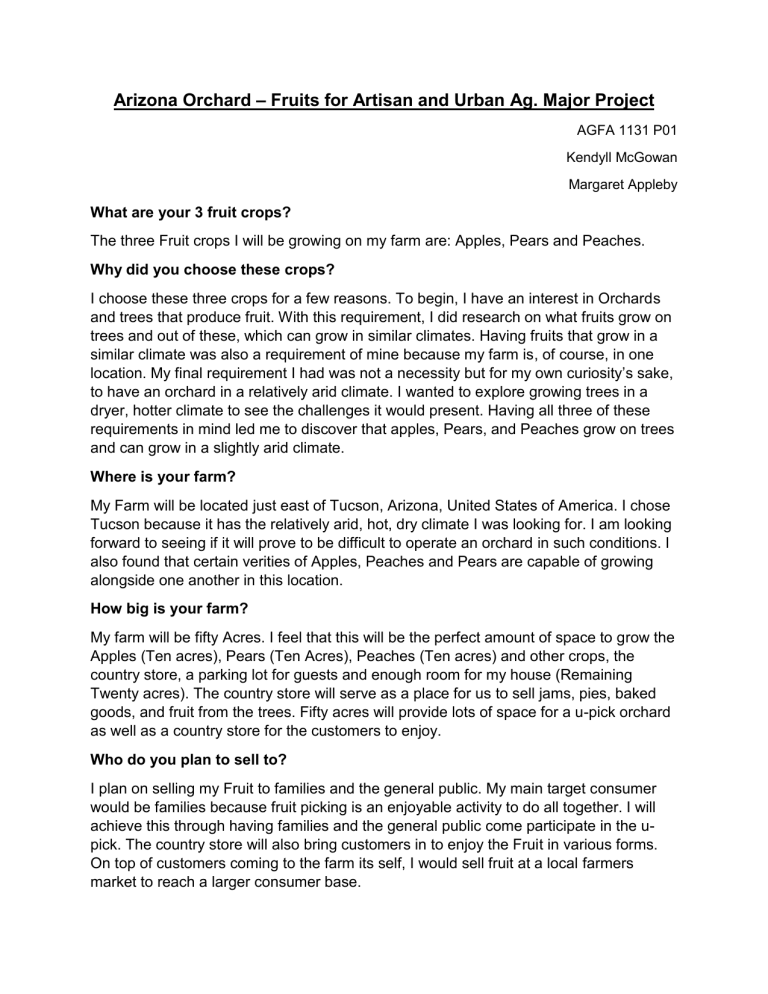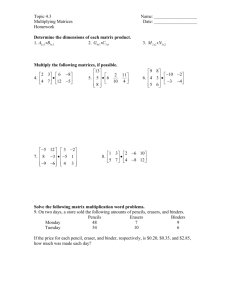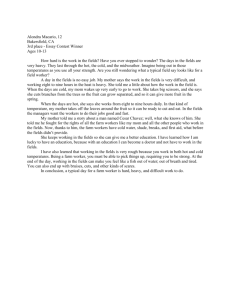
Arizona Orchard – Fruits for Artisan and Urban Ag. Major Project AGFA 1131 P01 Kendyll McGowan Margaret Appleby What are your 3 fruit crops? The three Fruit crops I will be growing on my farm are: Apples, Pears and Peaches. Why did you choose these crops? I choose these three crops for a few reasons. To begin, I have an interest in Orchards and trees that produce fruit. With this requirement, I did research on what fruits grow on trees and out of these, which can grow in similar climates. Having fruits that grow in a similar climate was also a requirement of mine because my farm is, of course, in one location. My final requirement I had was not a necessity but for my own curiosity’s sake, to have an orchard in a relatively arid climate. I wanted to explore growing trees in a dryer, hotter climate to see the challenges it would present. Having all three of these requirements in mind led me to discover that apples, Pears, and Peaches grow on trees and can grow in a slightly arid climate. Where is your farm? My Farm will be located just east of Tucson, Arizona, United States of America. I chose Tucson because it has the relatively arid, hot, dry climate I was looking for. I am looking forward to seeing if it will prove to be difficult to operate an orchard in such conditions. I also found that certain verities of Apples, Peaches and Pears are capable of growing alongside one another in this location. How big is your farm? My farm will be fifty Acres. I feel that this will be the perfect amount of space to grow the Apples (Ten acres), Pears (Ten Acres), Peaches (Ten acres) and other crops, the country store, a parking lot for guests and enough room for my house (Remaining Twenty acres). The country store will serve as a place for us to sell jams, pies, baked goods, and fruit from the trees. Fifty acres will provide lots of space for a u-pick orchard as well as a country store for the customers to enjoy. Who do you plan to sell to? I plan on selling my Fruit to families and the general public. My main target consumer would be families because fruit picking is an enjoyable activity to do all together. I will achieve this through having families and the general public come participate in the upick. The country store will also bring customers in to enjoy the Fruit in various forms. On top of customers coming to the farm its self, I would sell fruit at a local farmers market to reach a larger consumer base. Is it near an urban center or 100 miles of city? Yes, the farm is located just north of a small town called Willcox in Arizona. This town is 100km east from Tucson, a major city in Arizona, USA. Why did you pick this site? (soil, microclimate, other) I choose this site as a challenge, when you think of a fruit orchard, the last place that comes to mind is growing in a desert. The thought of successfully growing in dryer climates intrigued me, I thought it would be a great opportunity to explore the challenges of growing in arid climates. The farm is located north of willlcox, a small town in Arizona. This area is known as the sulphur springs Valley and at 4300’ meter elevation it provides warm days and cool nights which make for excellent Apple, Peach and Pear growing temperatures. The soil in the area is McAllister series. It is a fine loamy textured soil and has a pH of 8.2. The fine loam is excellent for fruit trees, however, the pH of the soil is too high, so soil nutrients additives will be required. What will you do prepare this site before you plant? To begin, the soil type is a very alkaline loam. It has a pH of 8.2, which is too high for apple, peach and pear trees. To have a successful orchard, we have to lower the pH of the soil. This can be done by adding certain nutrients to the soil: organic matter, aluminum sulfate, sulfur, peat. I would decide on the best nutrient option using trial and error. Next, I would dig up and cultivate the topsoil. After spreading the nutrients, I’ll rip up the soil both ways at a depth of 300-400mm using a small tractor and a pull plow. After ripping up the soil, I would begin to cultivate in rows keeping in mind the sun orientation for proper light exposure. I would also install the in ground irrigation system during this time. The next planting preparation step would be to hill up the surface soil, this can be done using a road grader. I’ll then allow local weeds or ryegrass to develop over autumn for sow use. In the spring, I will spray out the weeds and ryegrass with roundup to allow the fruit trees to not compete and to have the best possible chance. FRUIT CROP OPERATION Your 3fruit crops? Apples: All apples will be produced on a B9 rootstock. If unsuccessful, I will continue to experiment using trial and error to find the most successful rootstock for my apples. The next rootstock I will try after B9 is M9. I chose these two rootstocks due to their common success. Gala – harvest early August to late August. Red Delicious – Harvest late August through September Rome beauty – harvest early to mid September Pink lady – harvest mid to late October Peaches: The rootstock I’ll be using for the peaches will be using for the peaches is Bailey. I chose this rootstock because it is older, therefore trusted and has produced successful orchards for many decades. Sunshine – first peach of the season (yellow flesh freestone) Red Haven – yellow flesh freestone, considered the standard peach Suncrest – yellow flesh freestone, excellent flavour September sun – firm, fresh and sweet. Pears: The rootstocks I’ll be using for the pears will be old home x farmingdale. This rootstock has been around for a decently long time and has been trusted by many farmers. This rootstock is also Hardy and compatible with most varieties, making it an excellent place to begin. 20th century Olympic Bartlett Rosy Bartlett What planting system are you using for each of your fruit crops? (e.g. apples. high density system). Are you using a conventional, organic or a combination of both systems? Why? Name one pest and disease of each fruit crop and describe your pest management strategy for them. How will you manage weeds and vertebrate pests? How will you manage getting your perishable crop to market? CHALLENGES Outline the challenges that you have identified with these fruit crops and how you might overcome them. (e.g. protect for frost in spring and fall use frost fans).




